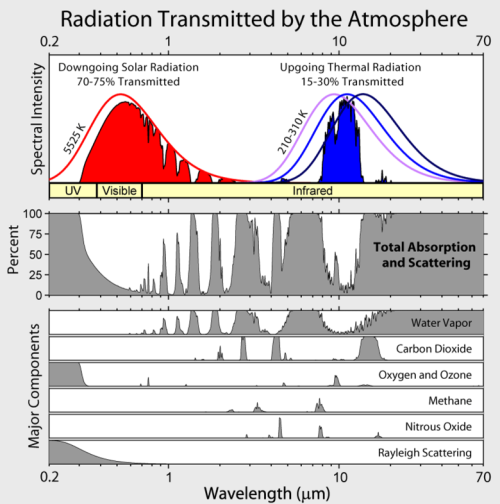Climate Crisis: Greenhouse Gas Physics
So I had promised that I would start writing about potential solutions to the climate crisis. As I started down that path, I realized that to discuss their relative importance or effectiveness requires a better understanding of the scale of the crisis. The alien invasion analogy sums it up as a single number: the excess energy above the pre-industrial baseline that we are adding to the atmospheric system amounts to 1 Hiroshima-sized nuclear bomb every second (all day, 365 days a year). But why is that and how come it is isn’t more immediately visible? So instead of writing about solutions, I have decided to add a few physics posts first.
The first one is about the basics of greenhouse gases, in particular carbon dioxide (CO2). The Wikipedia entry is an excellent resource, and from it comes this crucial chart:

What are we looking at? The horizontal axis of this is the wavelength of light ranging from ultraviolet (UV) on the left to infrared on the right, with the small band of visible spectrum between them (see the labels in the yellow area).
The top area of the chart shows that most of the light coming from the sun is in the visible spectrum (the big red “hump”) with some in UV (which gives us sunburns). This sun light heats up buildings, soil, water, etc. during the day. As those things warm up they start to give off infrared light which is radiated back into the atmosphere. That’s the blue “hump” in the top portion of the chart.
Below in the grey area of the chart is the total absorption and scattering of light by the atmosphere at first and then decomposed into its major components. It is here that we want to focus our attention. In particular, let’s look at the Carbon Dioxide line. What we can see by reading the chart vertically is that CO2 has some “humps” that line up with the incoming light from the sun, but the really big “hump” lines up with the radiation that’s trying to leave earth back into space once objects have warmed up and are giving off infrared light.
Hence the term greenhouse gas. Carbon Dioxide and Methane play essentially the same role as glass does in a greenhouse. They let the sunlight in (minimal absorption on the way down from the sun) but trap the heat (lots of absorption and scattering when heat tries to escape). There is also an important interaction with water vapor, which is the most potent of the greenhouse gases that’s well described in the Wikipedia entry.
Posted: 16th September 2019 – Comments
Tags:
climate crisis greenhouse gases physics
